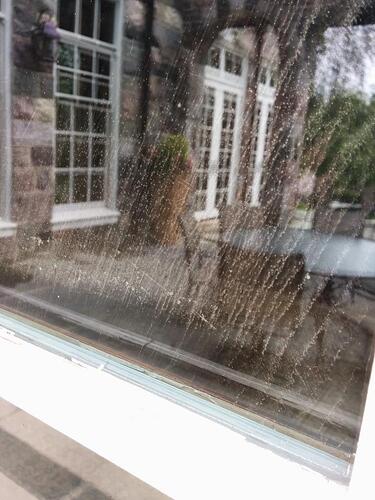i was thinking about this situation this afternoon, and i arrived at a conclusion- as manufacturing standards and coating strategies change in the industry, it’s going to become more and more important that we educated window cleaners stay abreast of what’s going on.
it’s pretty clear that we cant count on manufacturers to reach out to us with specific, consistent instruction on cleaning methods when it comes to the high-tech coatings they now use, and will continue to use in greater measure going forward. so, as unfair as it may seem, it’s on us to do the digging, the research and to put in the hustle necessary to stay on top of it.
so let’s say you’ve seen countless improperly assembled softcoat low-e coated windows in your 20 years of experience. and let’s say you’ve cleaned thousands of hardcoat low-e panes. and let’s say you know all about hardcoat abrading metal (such as scraper material), and you are well aware of the now ancient recommended solutions involving polishing compounds like Bar Keepers Friend…
in the end, so what? this is information that’s been in front of your nose for over a decade, if you’ve cared to look. however, the industry is changing.
we have no voice, as cleaners, when it comes to manufacturing guidelines (despite what various “associations” and “networks” may try to tell you). so ask yourself- “what can i do to help my business?”… “how can i continue to turn a healthy profit in the face on an evolving industry?” " how can I keep my valuable employees busy and productive, despite the challenges they face in the field?" “how can i minimize risk even as the potential for disaster increases?”
the answer is simple. [B]educate yourself[/B]. if that means turning to a google search, a six pack, and some microwave popcorn for a few hours, then so be it. It’s basically the wild west out here. there is no reliable resource other that what we make for ourselves. hopefully, you have a place turn to for reliable information, free of agenda or ego.
why do you think the WCRA has no official stance on:
-fabricating debris
-low-e glass cleaning practices
-scraper usage or lack thereof
?
My guess is this: because, basically, there’s enough anecdotal info out there for you to do a pretty good job of covering these bases on your own. and obsessing over these issues [B]will not help you grow your business, make you more money, or make your life easier as an owner.[/B]
And those things are what the WCRA is all about. isnt that why you started your business in the first place? to have ultimate control over your time and energy, to make more money, to provide meaningful employment to others you care about? i’m pretty sure it wasn’t in an effort to crusade against “the man” in the glass factory. if so, well, i’m sorry if my presumption offends you.
that’s why i love WCRA. real window cleaners helping real window cleaners with real info. no agendas, no egos, just squeegee slingers helping one another out.





